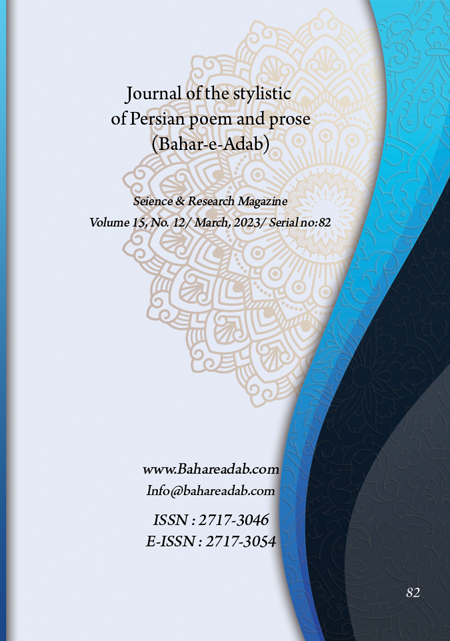- Count View : 337
- آدرس کوتاه شده مقاله: https://bahareadab.com/article_id/1410
- کد doi مقاله: Doi: 10.22034/bahareadab.2023 .15 .6698
Journal of the stylistic of Persian poem and prose
volume Number 15،
number In Volume 12،
،
issue Number 82
Stylistics of the Odes (Qasidas) of Mirza Seyyed Yahya Modarres alias Fadaei Yazdi
Fatemeh Chashnigir , Azizullah Tavakoli Kafiabad (Author in Charge), Mahmoud Sadeghzadeh
Abstract
BACKGROUND AND OBJECTIVES: Mirza Seyyed Yahya Modares, deceased (1282 AH), nicknamed Fadai Yazdi, is one of the scientific and literary figures of the Qajar era, who has numerous works in poetry and prose in Persian and Arabic. His divan is a collection of Sonnets (Ghazal), Odes (Qasida), Mathnavis (Masnavi), Pieces (Ghat’e) and Quatrains (Robaei). In addition, he has two poems in Arabic. This article is dedicated to examining the stylistic and content characteristics of his poems from linguistic, literary and intellectual aspects. The purpose of this study is to determine the ability of the poet as one of the ode writers of the Literary Return period.
METHODOLOGY: The present study is based on a descriptive-analytical method with library tools which has been done on a valid manuscript with the poet"s own handwriting in the personal library of Seyyed Yahya Modarresi.
FINDINGS: Fadai Yazdi has proved his ability in composing praise poems. His skill is in simile and metaphorical illustrations in the introduction of the odes. His poetry is full of beautiful literary industries. The use of expression techniques, especially sensory-to-sensory similes and novel balances and allusions, has a high frequency in his poetry. The choice of Bahr Mujtas and Raml makes the weight fit with the content and the use of heavy Arabic rhymes is one of the characteristics of his poetry. Intellectually, the main theme of his poems is praise, and his main praise is the great men of religion, especially Imam Ali (as). In the content of Fadaei Yazdi"s Odes, the description of nature and the beloved and also complaining about the life and the expression of despair and hopelessness can be observed.
CONCLUSION: Fadaei Yazdi has been a powerful ode composer. One of the prominent features of his poetry is the frequent use of words and combinations of Arabic language, which sometimes makes it difficult for the reader to understand the meanings of the poem. Like his contemporary poets, he followed Khorasani style and imitated predecessors and has considered their poetry in choosing weight, rhyme and themes of his poems. He was well acquainted with the poetic features of previous poets and has been able to reflect their linguistic, literary and intellectual features in his poems.
Keyword
Fadaei Yazdi
, Qajar
, Ode (Qasida)
, praise
, stylistics
, simile
- Arianpour, Y. (2000). From Saba to Nima. 4th Edition. Tehran: Zavvar, P. 19.
- Derayati, M. (2012). List of Manuscripts. 15th Edition. Tehran: National Documents and Libraries Organization of I.R. Iran, p. 658.
- Ebn Rashigh Ghirvani. A. (1955). Al-Omde. Mohammad Mohyeddin Abdolhamid. Cairo, p. 134.
- Fotouhi, M. (2011). Stylistics of theories, approaches and methods. Tehran: Sokhan, p. 307.
- Ghasemi, R. (2009). Comparative meanings and expression (Comparative study of sixteen new books on semantics and expression). Tehran: Ferdows, p. 304.
- Gholamrezaei, M. (1997). Poetry stylistics. Tehran: Jami, p. 206.
- Khatami, A. (1995). A study in poems and prose of literary return period. Tehran: Paya, p. 202.
- Shamisa, S. (1991). Bayan (Expression). Tehran: Ferdows, p. 19 & 341.
- Shamisa, S. (1995). Expression and meanings. Tehran: Ferdows, p. 38.
- Shamisa, S. (2000). Poetry stylistics. 6th Edition. Tehran: Ferdows, p. 30.
- Shamisa, S. (2004). A fresh look at the novelty. Tehran: Ferdows, p. 89.
- Shamlou, A. and Dezfoulian, K. (2008). Literary return and linguistic coordinates of the poetry of that period. History of Persian literature 59 (3), p. 97.
- Shirvani, M. (1969). List of manuscripts of Vaziri Library of Yazd. Tehran: National Literary Works Association, p. 1750.
- Tehrani, A. (1403 AH). Al-Zaree’a ela Tasanife Shee’e. V 9. Qom: Esmaeilian, p. 816.
- Vamegh Yazdi, M.A. (2002). Tazkere Meykade. Masarat, H. Yazd: Andishmandan, p. 36 & 46.

